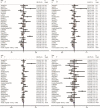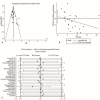Association between ERα gene Pvu II polymorphism and breast cancer susceptibility: A meta-analysis
- PMID: 29702977
- PMCID: PMC5944501
- DOI: 10.1097/MD.0000000000010317
Association between ERα gene Pvu II polymorphism and breast cancer susceptibility: A meta-analysis
Abstract
Background: Estrogen has played an important role in the development of breast cancer. ER-α PvuII gene polymorphism is in close association with the occurrence risk of breast cancer, but no consensus has been achieved currently.
Methods: PubMed, Embase, China National Knowledge Infrastructure (CNKI) database, Wanfang database, and VIP database were retrieved to collect the case-control studies on association between ERα gene Pvu II polymorphism and breast cancer risk published before September 1, 2017. Newcastle-Ottawa Scale (NOS) was used to assess the quality of the literatures, Stata 14.0 software was applied for meta-analysis, and the pooled odds ratio (OR) and 95% confidence interval (95% CI) were calculated. The subgroup analysis was performed to assess the confounding factors, followed by assessment of publication bias and sensitivity analysis.
Results: A total of 26 studies were enrolled in the analysis based on inclusion criteria, which included 15,360 patients and 26,423 controls. The results demonstrated that ERα gene Pvu II polymorphism was in significant association with the decrease of breast cancer risk in 3 genetic models (C vs T, OR = 0.962, 95% CI = 0.933-0.992, P = .012; CC vs TT, OR = 0.911, 95% CI = 0.856-0.969, P = .003; CC vs TT/CT, OR = 0.923, 95% CI = 0.874-0.975, P = .004). Subgroup analysis was conducted on the basis of ethnicity and source of controls, whose results illustrated that ERα gene Pvu II polymorphism was in significant association with the decrease of breast cancer risk in Asians rather than in Caucasians (CC vs TT, OR = 0.862, 95% CI = 0.750-0.922, P = .038; CC vs TT/CT, OR = 0.851, 95% CI = 0.755-0.959, P = .008). In population-based subgroup rather than in hospital-based subgroup, ERα gene Pvu II polymorphism was in significant association with the decrease of breast cancer risk in the allele model, homozygous model, dominant model, and recessive model (C vs T, OR = 0.943, 95% CI = 0.911-0.977, P = .001; CC vs TT, OR = 0.878, 95% CI = 0.817-0.944, P = .000; CC/CT vs TT, OR = 0.936, 95% CI = 0.881-0.994, P = .031; CC vs TT/CT, OR = 0.902, 95% CI = 0.847-0.960, P = .001).
Conclusion: ERα gene Pvu II polymorphism exerts an important function in the progression of breast cancer.
Conflict of interest statement
The authors have no conflicts of interest to disclose.
Figures



Similar articles
-
Association of oestrogen receptor alpha gene polymorphisms with systemic lupus erythematosus risk: An updated meta-analysis.Microb Pathog. 2019 Feb;127:352-358. doi: 10.1016/j.micpath.2018.12.029. Epub 2018 Dec 17. Microb Pathog. 2019. PMID: 30572014 Review.
-
No association of the TGF-β1 29T/C polymorphism with breast cancer risk in Caucasian and Asian populations: evidence from a meta-analysis involving 55,841 subjects.Asian Pac J Cancer Prev. 2014;15(20):8725-34. doi: 10.7314/apjcp.2014.15.20.8725. Asian Pac J Cancer Prev. 2014. PMID: 25374198 Review.
-
Association between polymorphisms in the estrogen receptor alpha gene and osteoarthritis susceptibility: a meta-analysis.BMC Musculoskelet Disord. 2015 Feb 27;16:44. doi: 10.1186/s12891-015-0506-5. BMC Musculoskelet Disord. 2015. PMID: 25887457 Free PMC article. Review.
-
MTHFR C677T polymorphism associated with breast cancer susceptibility: a meta-analysis involving 15,260 cases and 20,411 controls.Breast Cancer Res Treat. 2010 Sep;123(2):549-55. doi: 10.1007/s10549-010-0783-5. Epub 2010 Feb 9. Breast Cancer Res Treat. 2010. PMID: 20143151
-
The association between IL-1 family gene polymorphisms and colorectal cancer: A meta-analysis.Gene. 2021 Feb 15;769:145187. doi: 10.1016/j.gene.2020.145187. Epub 2020 Sep 28. Gene. 2021. PMID: 32998046 Review.
Cited by
-
Association between GPER gene polymorphisms and GPER expression levels with cancer predisposition and progression.Heliyon. 2021 Mar 10;7(3):e06428. doi: 10.1016/j.heliyon.2021.e06428. eCollection 2021 Mar. Heliyon. 2021. PMID: 33748487 Free PMC article.
-
Analysis of Single Nucleotide Polymorphisms (SNPs) rs2234693 and rs9340799 of the ESR1 Gene and the Risk of Breast Cancer.In Vivo. 2024 Sep-Oct;38(5):2134-2143. doi: 10.21873/invivo.13676. In Vivo. 2024. PMID: 39187368 Free PMC article.
-
Metabolic Syndrome, BMI, and Polymorphism of Estrogen Receptor-α in Peri- and Post-Menopausal Polish Women.Metabolites. 2022 Jul 22;12(8):673. doi: 10.3390/metabo12080673. Metabolites. 2022. PMID: 35893240 Free PMC article.
-
Correlation of FGFR2 rs2981582 polymorphisms with susceptibility to breast cancer: a case-control study in a Chinese population.J Int Med Res. 2019 Oct;47(10):4753-4763. doi: 10.1177/0300060519869058. Epub 2019 Aug 26. J Int Med Res. 2019. PMID: 31448667 Free PMC article.
-
Relationship between TGF-β1 + 869 T/C and + 915 G/C gene polymorphism and risk of acute rejection in renal transplantation recipients.BMC Med Genet. 2019 Jun 25;20(1):113. doi: 10.1186/s12881-019-0847-2. BMC Med Genet. 2019. PMID: 31238890 Free PMC article. Review.
References
-
- Torre LA, Bray F, Siegel RL, et al. Global cancer statistics, 2012. CA Cancer J Clin 2015;65:87–108. - PubMed
-
- Chen WQ, Zheng RS, Baade PD, et al. Cancer statistics in China, 2015. CA Cancer J Clin 2016;66:115–32. - PubMed
-
- Goss PE, Strasser-Weippl K, Lee-Bychkovsky BL, et al. Challenges to effective cancer control in China, India, and Russia. Lancet Oncol 2014;15:489–538. - PubMed
-
- McCormack VA, Boffetta P. Today's lifestyles, tomorrow's cancers: trends in lifestyle risk factors for cancer in low- and middle-income countries. Ann Oncol 2011;22:2349–57. - PubMed
Publication types
MeSH terms
Substances
LinkOut - more resources
Full Text Sources
Other Literature Sources
Medical
Miscellaneous

